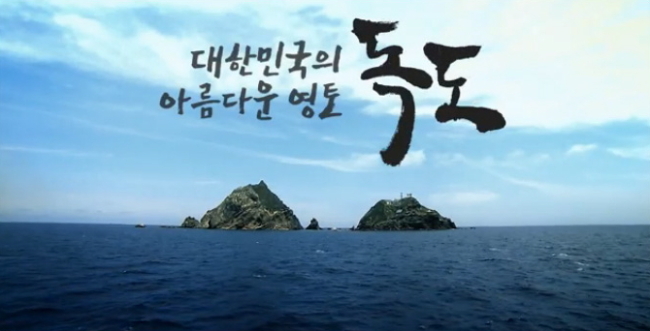 |
A still image of a promotional video on Dokdo released Wednesday by the Foreign Ministry on its website and on YouTube. (Foreign Ministry) |
Korea unveiled a new promotional video on Dokdo on Wednesday, countering Tokyo’s increasing territorial assertions and lambasting Japanese politicians’ visits to a controversial war shrine.
The 260-second clip was released at midnight on YouTube and the Foreign Ministry’s website (dokdo.mofa.go.kr). It was an update to a previous piece that was uploaded in late October but taken down shortly due to its unauthorized use of clips from Japanese broadcaster NHK.
The latest version is much shorter than the first 12-minute version, and seemingly carried clearer, more concise messages.
It said Dokdo was “the first victim of Japan’s invasion” of the peninsula, referring to a number of old Korean and Japanese records and maps that categorized the islets as Korean territory.
The video also stressed Dokdo as a symbol of Korea’s restoration of sovereignty, citing the 1943 Cairo Declaration, which read “Japan will also be expelled from all other territories which she has taken by violence and greed.” The statement by three Allied Powers ― the U.S., Britain and China ― set out a plan for the terms of Japan’s defeat in World War II and Korea’s independence.
Later, the clip dismissed Tokyo’s claim as an attempt to repeat its imperial history, while showing 168 Japanese politicians worshipping en masse at the Yasukuni Shrine in April, which prompted protests from Korea and China. Further backlash erupted last week after Japanese Prime Minister Shinzo Abe became the country’s first leader to visit the temple in nearly eight years.
Located between the two countries and interlaced in their bitter shared history, the small islets lie in rich fishing grounds and are surrounded by large underground reserves of natural gas and other resources.
Japan in 1905 covertly incorporated Dokdo as a military post during its war against Russia before colonizing the entire peninsula in 1910. The islets were returned to Korea upon its liberation following Tokyo’s surrender in World War II.
The new film marked the latest in a series of media offensives being waged by the two countries, as their relations continue to sour amid Abe’s push for nationalist policies.
In late October, Tokyo published its own 90-second clip on the islets, which it calls Takeshima, to counter Korea’s initial upload. It argues in 11 languages that Seoul “illegally occupies” the rocky outcrops, which it claims Japan effectively governed until the mid-17th century.
Seoul lodged a protest at once, calling it an “anachronistic provocation” and urging an immediate removal. Its Foreign Ministry is working to translate its video into 12 languages and distribute relevant maps, books and other documents through embassies. It also supports research programs at major international think tanks, and hosts briefings and lectures at diplomatic academies overseas.
The ministry is forecast to secure 6.84 billion won ($6.55 million) for Dokdo-related expenses this year, up 61.4 percent from last year.
Tokyo, for its part, raised its budget for territorial issues by nearly 24 percent to 1 billion yen ($9.5 million) this year. The funds also target a separate dispute over the Senkaku or Diaoyu Islands in the East China Sea, which are claimed by China.
The Japanese Foreign Ministry is reportedly planning a tour early this year for more than 100 foreign correspondents based in Seoul to Shimane Prefecture and Okinawa. The program will include interviews and seminars designed to highlight its claims to Dokdo and the Senkakus, according to Kyodo News.
By Shin Hyon-hee (
heeshin@heraldcorp.com)




![[Weekender] Korea's traditional sauce culture gains global recognition](http://res.heraldm.com/phpwas/restmb_idxmake.php?idx=644&simg=/content/image/2024/11/21/20241121050153_0.jpg)



